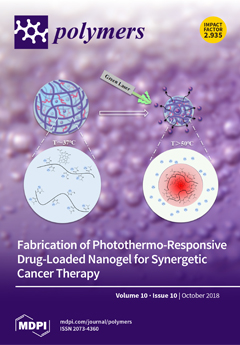1
Innovation Platform of Intelligent and Energy-Saving Textiles, School of Textiles, Tianjin Polytechnic University, Tianjin 300387, China
2
Tianjin and Education Ministry Key Laboratory of Advanced Textile Composite Materials, Tianjin Polytechnic University, Tianjin 300387, China
3
Laboratory of Fiber Application and Manufacturing, Department of Fiber and Composite Materials, Feng Chia University, Taichung 40724, Taiwan
4
Department of Bioinformatics and Medical Engineering, Asia University, Taichung 41354, Taiwan
5
Department of Chemical Engineering and Materials, Ocean College, Minjiang University, Fuzhou 350108, China
6
College of Textile and Clothing, Qingdao University, Qingdao 266071, China
7
School of Chinese Medicine, China Medical University, Taichung 40402, Taiwan
8
Department of Fashion Design, Asia University, Taichung 41354, Taiwan
Abstract
The aim of this study was to investigate the feasibility of large-scale preparation of porous polyvinyl alcohol/sodium alginate/graphene (Gr) (Gr-AP) nanofiber membranes using a copper wire needleless dynamic linear electrode electrospinning machine. Furthermore, the effects of Gr concentrations (0, 0.0375, 0.075, 0.25, 0.5,
[...] Read more.
The aim of this study was to investigate the feasibility of large-scale preparation of porous polyvinyl alcohol/sodium alginate/graphene (Gr) (Gr-AP) nanofiber membranes using a copper wire needleless dynamic linear electrode electrospinning machine. Furthermore, the effects of Gr concentrations (0, 0.0375, 0.075, 0.25, 0.5, and 0.75 wt.%) on the morphology, electrical, hydrophilicity and thermal properties were evaluated. Results indicate that the dynamic linear electrospun Gr-AP membranes have a high yield of 1.25 g/h and are composed of porous finer nanofibers with a diameter of 141 ± 31 nm. Gr improved the morphology, homogeneity, hydrophobicity and thermal stability of Gr-AP nanofiber membranes. The critical conductive threshold is 0.075 wt.% for Gr, which provides the nanofiber membranes with an even distribution of diameter, an optimal conductivity, good hydrophilicity, appropriate specific surface area and optimal thermal stability. Therefore, needleless dynamic linear electrospinning is beneficial to produce high quality Gr-AP porous nanofiber membranes, and the optimal parameters can be used in artificial nerve conduits and serve as a valuable reference for mass production of nanofiber membranes.
Full article






